|
San Diego Trust & Savings Bank Building
An elegant lesson in adaptive reuse
By Pamela Hartwell
Just adjacent, a doorway has been cut through to the elevator lobby and provides access to the guest rooms, formerly the building's offices. Because there is a gradient change of several steps down to this lobby, a mini-elevator has been installed that accommodates wheel chairs, thus serving the needs of handicapped and disabled guests," observed Alan Winthrop Johnson, son of the landmark building's original architect, William Templeton Johnson, on a visit with his niece, Julia Johnson Iavelli, to the newly opened Courtyard-Marriott Hotel a decade ago. From 1928 until March 18, 1994, the building at Sixth & Broadway served as the headquarters for San Diego Trust & Savings Bank.
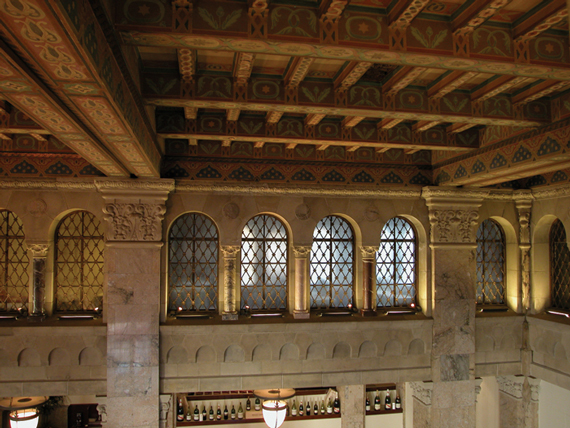
Mezzanine showing the full court of materials including marble, bronze with elaborate stenciled beamed ceiling.
"The interior of the banking hall is truly medieval in ambiance. As you enter from Broadway, you will note at the clerestory level, near the ceiling, there is an imposing arrangement of arches and marble columns round the hall. The columns are special. There are 35; representing 19 different types of marble from the shores of the Mediterranean Sea. The columns are décorative, they do not support the ceiling, which is suspended," according to Captain Theodore H. Davie, the Bank's historian and a former occupant of one of the Bank building's offices.
Captain Davie further revealed, "The building is generally regarded as a fine example of the Italian Romanesque Revival style. The Romanesque was the predominant style for churches, monasteries, and other buildings constructed during the Middle Ages in Europe. It is characterized by the use of ornamentation: Arches, vaults, arcades, shields, and medallions."
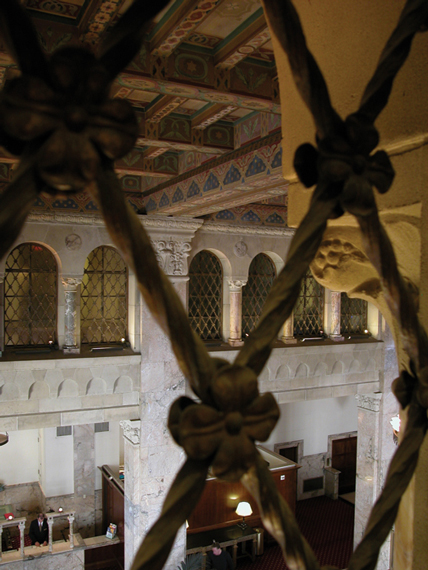
View from mezzanine to first floor through the bronze fittings.
|

The massive circular vault door, bearing the stamp "Donsteel Door" was manufactured by the Mosler Safe Company of Hamilton, Ohio. The door cost $900, including a 25% discount, and was installed in 1928. This perfectly balanced stainless steel door, hangs on enormous hinges, and weighs 47,000 pounds. "You can just touch it with your finger and it closes," shares Jeanne Tuck, who, along with her husband, Roger, were career staff members. Roger continues, "One of the tasks for a new lending officer was to open and close the vault, which always involved two people, each one knowing one part of the combination."
|
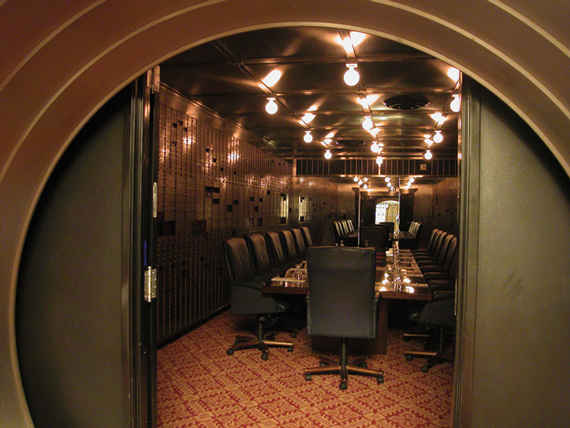
After the Bank became a hotel the formidable vault door was left open revealing safe deposit boxes along the walls. The vault serves as an appropriate gathering area for San Diego Trust & Savings Bank staff reunions.
|
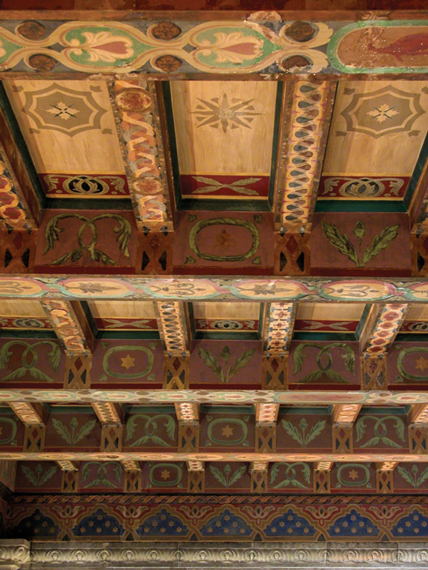
Close up view of stenciled ceiling.
|
In 1926, Joseph W. Sefton, Jr., president of San Diego Trust & Savings Bank, selected William Templeton Johnson to be the architect of his bank's planned headquarters' building," shared Captain Davie. (The Bank had opened its doors 37 years earlier as the San Diego Savings Bank under the founding leadership of Joseph W. Sefton, Sr.) Captain Davie continued, "In practice for 15 years, Templeton Johnson was approaching the zenith of his career, having brought into life a number of notable buildings, many located in San Diego." Other major architectural achievements by Templeton Johnson include: Samuel I. Fox building (1928) at 6th & Broadway, southwest corner; Serra Museum (1929) at Presidio Park; U. S. Post Office (1937) at 8th & E; San Diego Consolidated Gas & Electric building (major remodel) at Kettner & Broadway; and splendid Balboa Park landmarks, San Diego Museum of Art (1926), and San Diego Natural History Museum (1933).
"William Templeton Johnson was trained in the Beaux-Arts tradition, where he was subjected to an intensely disciplined approach to design. He early developed an interest in Mexican and Spanish arts and architecture. Although the Spanish Colonial attracted him, Templeton Johnson felt comfortable with other architectural styles as well," added Captain Davie.
Construction of the San Diego Trust & Savings Bank building occurred in 1927, according to Tom Sefton, the founder's grandson.
"The exterior of the structure is clad in a base of Scotch Rose granite that supports two stories of sandstone quarried in Ohio. The light brown variegated stone is matched by terra-cotta in use from the second story to the cornice line at the top of the 14th story. The finest structural materials were assembled from all over the western world for this building. There are a variety of colorful marbles, durable granite, sandstone, sculptured bronze for doors, glass-framed-in-bronze for windows, and an abundance of wrought iron. The steel frame building with vertical columns and steel horizontal girders is reinforced with concrete. The interior is faced with escalette marble, the predominant marble used. The large banking hall, 32 feet high, dominates the first floor. A 14-story building is situated on top of the banking hall. Adding to the overall height is a two-story penthouse, and, on top of that, a large cupola," reported Captain Davie.
The magnificent San Diego Trust & Savings Bank and office building was opened to great acclaim on April 14, 1928.
As Alan Johnson and his niece continued their tour through the recently remodeled building, they discovered that Templeton Johnson's former office and library was particularly nostalgic. Alan Johnson observed, "What was originally the architect's (his father's) business address, 1400 San Diego Trust & Savings Bank Building, presently rooms 1402-03, is now the Presidential Suite. Templeton Johnson's former library, with its beautiful painted plaster ceiling and supplementary décor intact, is the master bedroom of the suite. When the architect retired in 1954, the contents of his library were given to the San Diego Public Library (1954) at 9th & E, the last of Templeton Johnson's notable public buildings."
Another striking change was noticed by Alan Johnson. "The spacious meeting room in the old and formidable vault is sure to provide a few laughs, but perhaps also invoke a sense of seriousness and integrity to any business conducted there." Alan Johnson recalled an extraordinary event that occurred years earlier. "The impressive banking room of San Diego Trust had served the city in ways other than just banking. For instance, nearly two decades ago there was an innovative chamber music group in San Diego that liked to arrange intimate concerts in unique settings, selecting the artistic nature of the music to be performed in ways relevant to the type of architecture represented in the building's design. San Diego Trust's banking room floor was cleared and seating was brought in. The music chosen was entirely Italian Baroque, a fine conjuncture of the two art forms. The greatly appreciative audience was treated to a unique cultural experience. The entire event was symbolic of the kind of concern and caring shown by the Bank's management, under the leadership of the Sefton family, to extending itself, in unusual ways such as this, to best serve the interests of the San Diego community."
Captain Davie described the configuration of the great banking room. "Before conversion, three sets of four teller stations were placed between the square pillars on the right side. Each station included the main parts of classical architecture in reduced size, the horizontal entablature resting on the two vertical columns and consisting of cornice, frieze, and architrave. Strong structures supported a bronze hinged wicket at each of the 16 positions. Some of these groupings have been rearranged to accommodate hotel design requirements."
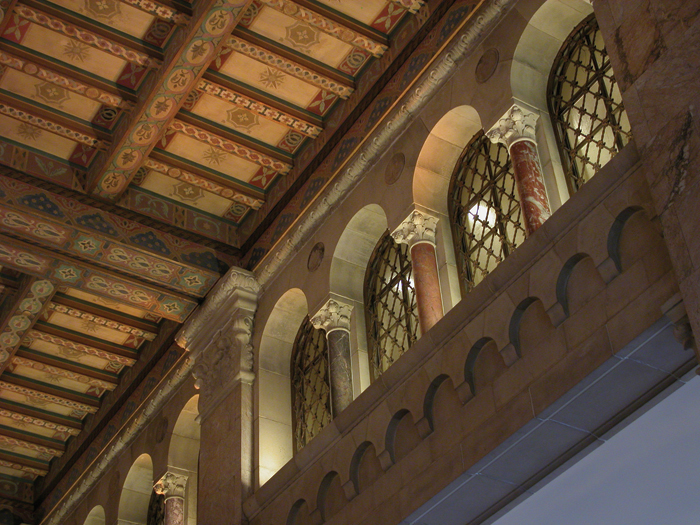
Marble features prominently throughout the building. Nineteen types of marble, obtained from the U.S., Great Britain, and countries around the Mediterranean Sea, comprise decorative columns in an expansive lobby. Corinthian capitals top each marble column. Escalette marble from France decorates walls, pilasters, and counters. The floor of Gray Eagle Quarry marble from Tennessee is bordered with Verde Antique, a deep green marble, both serpentine and mottled.
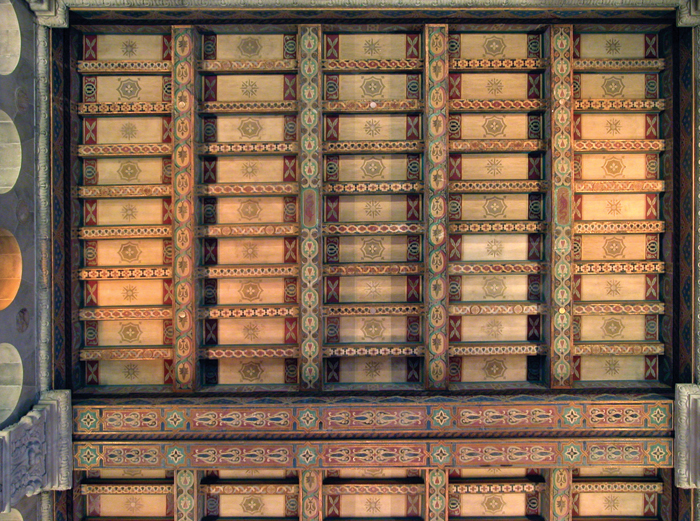
This exquisite coffered plaster ceiling, painted with colorful designs, soars thirty-two feet above the ground floor of the banking hall, and complements the Italian Romanesque Revival style of the historic bank building. A similar ceiling is preserved in the Presidential Suite, which, until 1954, housed the office and library of William Templeton Johnson, the building's architect.
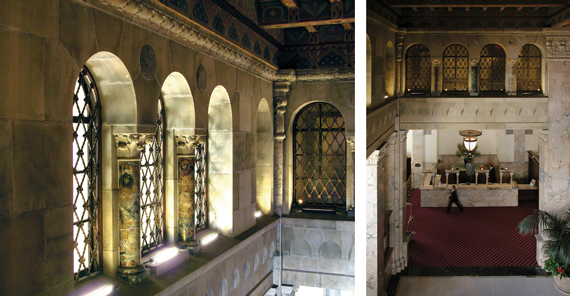
(Left) Medallions, arches, and decorative bronze window grilles at the clerestory level in the banking hall contribute to the building's medieval ambiance. Virtually all of the original design elements of the 1928 structure remain intact. Some elements were creatively readapted, where necessary, by its current occupant, the hotel. (Right) The Bank went through its own restoration of original elements in 1979 under the direction of president, Tom Sefton. The original marble and bronze teller stations were brought out of storage to restore the stations from 'modern improvements' that had been made.
Asked what might be the reaction of his father, Templeton Johnson, to the owner's redevelopment proposal for the bank building, (J. P. Morgan is the current owner) Alan Johnson responded, "I'm sure he would have liked it," he then recounted this quotation from Plato. 'The magic of imagination is only this, to glimpse through the changing what the changing means.' "My father was neither a liberal nor a conservative. He was both, depending on what the situation was; and this proposal (conversion of the structure to a hotel) is novel. The successor owners, architects, and builders have created a whole new and useful life for this classic old building while recognizing and preserving its history and its exemplary merit as fine art in architecture. To him, it would have made good sense!"
Although the use of the San Diego Trust & Savings Bank building changed ten years ago, from a bank and offices to a hotel with 245 guest rooms, the original features of the structure remain remarkably intact. The Courtyard-Marriott Hotel, located in the heart of a vibrant downtown San Diego, is a spectacular example of successful readapted use. The hotel stands proud in the bank's place, as the sentinel of an important piece of San Diego history.
Courtyard by Marriott - This excellent example of adaptive reuse was a 1999 People In Preservation award winner.
Former vice president with San Diego Trust and Savings Bank, Pamela Hartwell is currently a board member of the Committee of One Hundred, the San Diego Youth Symphony, the San Diego Art Institute, and serves on committees for the Friends of Balboa Park, the San Diego Natural History Museum, Mingei International Museum, and the San Diego Museum of Art. Photography by PACEM.
|
MORE FROM THIS ISSUE
From the Editor
2009 People In Preservation Award Winners
Historic Preservation & Environmental Conservation
The Green Game
Making your historic home more energy efficient
Your home's landscape is green in more ways than one
San Diego Trust & Savings Bank Building
Black Gold in San Diego
2009 Most Endangered List of Historic Resources
Tragedy Unfolds
Preservation Community
Reflections
Recognition
The Whaley House Porch Returns
Museum News: Marston House
Borrego Springs Modern lll
Borrego's future lies in its past
Adobe University
An Enchanted Evening at PIP
Looking for historic homes, gardens or commercial sites
Help Us
Lost San Diego
Strength in Numbers
Advertisements
DOWNLOAD full magazine as pdf (9.7mb)
|











